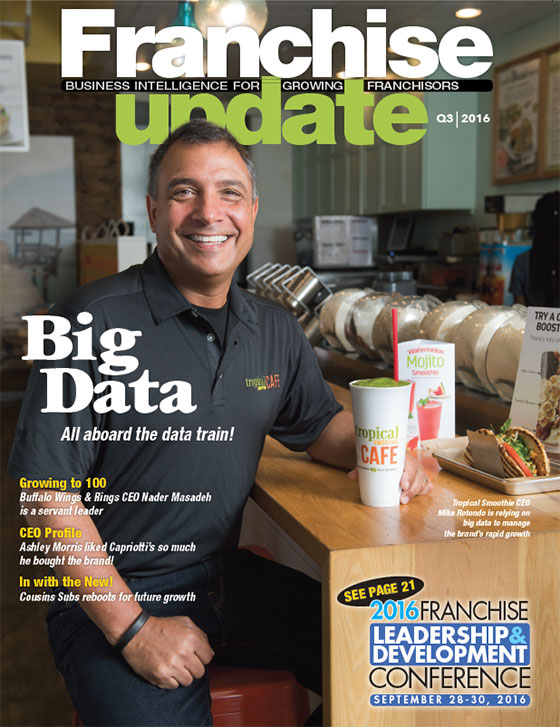Protecting the Model: Defining and Defending Franchising in 2016

We all get the calls: "What's the best franchise these days?" How do you answer that? Usually, the answer is a muddled, meandering set of comments. Before I get into why we should find it easy to answer that question and how to do so, I think it's important to know what the cost is of not being able to answer that question. How about the future vitality of the franchise business model?
I think it is reasonable to associate a significant portion of franchising's inability to answer that question with more than 30 state legislative initiatives, periodic federal legislative efforts (two bills now pending), countless legal proceedings, regulatory attacks on many fronts, and plenty of of negative press. Most of this came about because of the absence of a common understanding of the business model and a common way to assess its strengths and weaknesses.
A necessary first step is to get a common understanding of the business model solved. This is what the IFA is taking on with its initiative to "change the narrative," led by IFA Chair Aziz Hashim. That is necessary, but not sufficient. If we don't have a common way to assess the business model, we will continue to allow others to do it for us.
Moving to an answer
Answering a question about what an average franchise brand looks like should be easy. We're not trying to explain some abstract technical topic. We're simply trying to explain what a good franchise system should look like to a prospective franchisee. Best and worst are just the outer boundaries of what average is, so let's start our understanding of how to address that question by defining "average." To do so we need a perspective, a vantage point if you will. The franchise business model involves four basic perspectives: 1) the franchisee/prospective franchisee, 2) the third-party debt capital provider, 3) the franchisor/brand owner, and 4) the consumer of the product or service.
Since most people asking the question of what is a good franchise system are coming from the perspective of the prospective franchisee, let's start there. Is it really that difficult to provide a simple answer using a few key pieces of information that would inform the prospective franchisee about a brand? Common sense tells me that if we can't, then we deserve to let people with agendas do it for us.
If I am able to achieve the average performance in your system, what will I be doing in the way of financial performance? I know all the excuses: "We have different models operating in different types of communities with different ages of performance and different investment requirements and different everything." Fine, but I didn't ask you what was different. I asked you to tell me what I should expect if I'm no better than average. I didn't ask for any assurances, I merely wanted to know if you know what you should know and can tell me.
I also want to know what the probability of failure is. You may have the best average financial performance in the industry, but if that comes with a high likelihood of failure, I want to know that. (So does my lender... and they do know because they're getting FUND reports.) From a prospective franchisee's perspective, there are a few other things I'd like to know that become a bit subjective, but these two things are (or should be) totally quantitative. The argument for not providing them is no longer relevant because if you don't, someone will publicly "guess" what they are and you will continue to be put into a category that might not be accurate.
"Average" by definition implies a comparison. If it's standardized and consistently measured, we have the basis of making a rating system. It is relatively easy to re-sort the roughly 3,500 brands into appropriate groups for comparisons if we have a basic understanding of what we are measuring.
For out part, FRANdata decided to get into the franchise brand rating game because we believe the future success of the business model demands it. We started with rating the systemic credit risk of franchise systems for debt capital providers. FUND scores will become as important to franchise loan underwriting as FICO scores are for assessing individual borrower creditworthiness. We also are pushing into franchisor performance benchmarking studies across the functional areas franchisors are responsible for. We also are supporting media articles like the Forbes list of best and worst franchises because we strongly believe the franchise business model should be correctly understood by the media before they start assessing it.
Within the franchise community, if we don't define what best, worst, and average are, we will continue to be vulnerable to those who want to do so for purposes that often don't include the best interests of the franchise business model. We're trying to catch up and pass them by doing it the right way--before the wrong way becomes common perception, regulation, and legislation.
Darrell Johnson is CEO of FRANdata, an independent research company supplying information and analysis for the franchising sector since 1989. He can be reached at 703-740-4700 or djohnson@frandata.com.
Share this Feature
Recommended Reading:
Comments:
comments powered by DisqusFRANCHISE TOPICS
- Multi-Unit Franchising
- Get Started in Franchising
- Growth
- Operations
- Open New Units
- Leadership
- Marketing
- Technology
- Legal
- Awards
- Rankings
- Trends
- Featured Franchise Stories
FEATURED IN

Franchise Update Magazine: Issue 3, 2016






 The franchise listed above are not related to or endorsed by Franchise Update or Franchise Update Media Group. We are not engaged in, supporting, or endorsing any specific franchise, business opportunity, company or individual. No statement in this site is to be construed as a recommendation. We encourage prospective franchise buyers to perform extensive due diligence when considering a franchise opportunity.
The franchise listed above are not related to or endorsed by Franchise Update or Franchise Update Media Group. We are not engaged in, supporting, or endorsing any specific franchise, business opportunity, company or individual. No statement in this site is to be construed as a recommendation. We encourage prospective franchise buyers to perform extensive due diligence when considering a franchise opportunity.